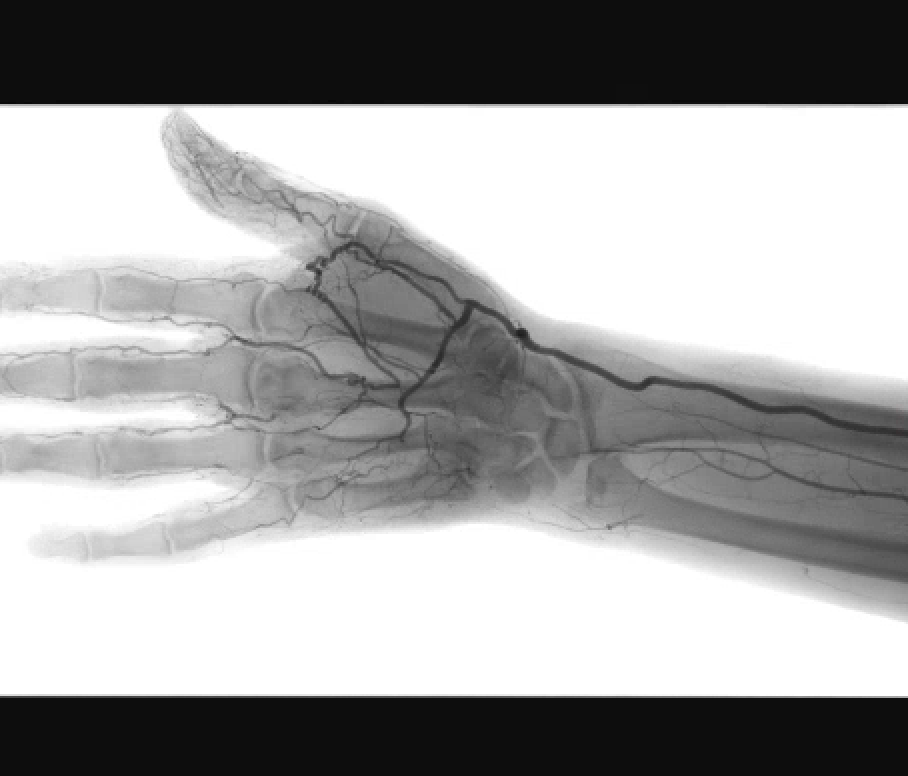Case Presentation: 61-year-old Caucasian male with a medical history significant for tobacco use disorder, and hypothyroidism presented to the emergency department (ED) with a two-week history of pain, numbness, and sensation of coolness affecting the inner aspect of right wrist/hand, fourth and fifth fingers unable to do his job as a house contractor. The symptoms were intermittent for a few months, but they became persistent after sustaining trauma to his inferior palm along with a decrease in strength. The symptoms were not related to arm position, cold exposure, rash, chest pain, shortness of breath, or similar symptoms in his other extremities. His physical exam was significant for pallor and relative coolness over the ulnar side of his right hand, fourth and fifth digit; an ulnar pulse of 1+, and normal sensation and range of hand motion. Allen’s test elicited palmar pallor on occlusion of the right radial artery and release of the right ulnar artery. Labs were essentially normal. With his history and physical exam suggestive of hand ischemia, a CT angiogram (CTA) of his right upper extremity was done which showed marked attenuation of the distal ulnar artery and digital arteries strongly suggesting hypothenar hammer syndrome. Given there were no symptoms of threatened limb ischemia, he was discharged on aspirin, high-dose statin, smoking cessation counseling, and instruction to follow up with vascular surgery. Diagnostic catheter angiography done as an outpatient of the right upper extremity demonstrated occlusion of the right ulnar artery beginning at the level of the mid-forearm, occlusion of the distal ulnar artery and superficial palmar arch, and attenuation of the digital branches of the fourth and fifth digits. He followed up with vascular surgery and is continued on conservative management with aspirin, clopidogrel, nifedipine, and encouragement on smoking cessation. To date, on follow up his symptoms are well controlled on the above regimen.
Discussion: Hypothenar hammer syndrome (HHS) is characterized by post-traumatic vascular insufficiency of the hand caused by constant compression over the hypothenar eminence (1). It is an uncommon cause (prevalence < 1% of the general population) of unilateral Raynaud's phenomenon in blue-collar male workers who use their hypothenar eminence to hammer objects as part of their work (2). HHS is an underdiagnosed but treatable cause of secondary Raynaud's phenomenon and hand ischemia (3). Symptoms classically include pain over the hypothenar eminence, cold intolerance/ sensation, numbness, cyanosis, ulceration, and ischemia of the ring and small fingers, possibly including the middle and index fingers (4). Allen's test is not specific but may be helpful to assess for palmar arch insufficiency. Diagnosis may be made by digital subtraction arteriogram, CT angiography, MRA, or ultrasound. Treatment is initially conservative, which includes avoidance of inciting trauma, palmar padding, smoking cessation, antiplatelet, and vasodilator therapy. Surgical management is reserved for severe cases with digit ischemia or the presence of a large aneurysm (4).
Conclusions: This case report is to raise awareness of HHS and to increase suspicion of this disorder so that further exposure to risk factors can be avoided and improve their overall prognosis (5). It is important to differentiate HHS from other causes of hand ischemia like Raynaud’s disease/phenomenon, Buerger’s disease, vasculitic/embolic phenomenon, and thoracic outlet obstruction (6).

